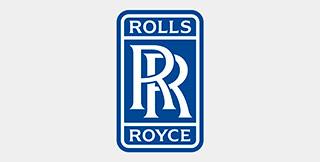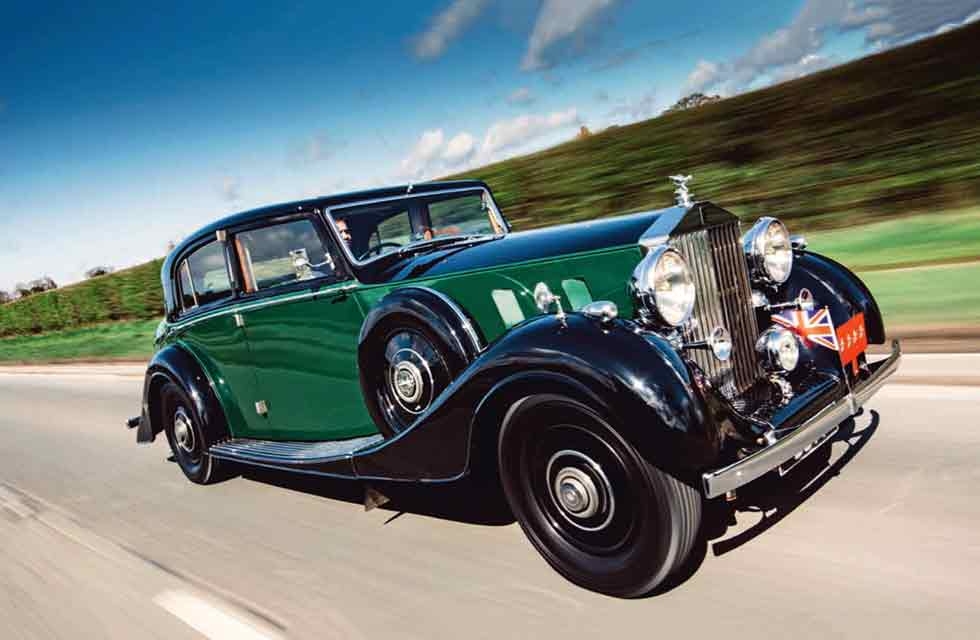
Monty’s Other Phantom Only the best staff cars would do for Field Marshal Montgomery, such as this Rolls-Royce loaned to the Ministry of War Transport. Words Ross Alkureishi. Photography Malcolm Griffiths/REX Features.
WAR HERO ON A ROLLS
Field Marshal Montgomery travelled in style aboard this loaned Phantom III
Summer 1939. The dark clouds that had been gathering malevolently over the preceding years had brought Europe to the edge of the precipice. The coming new war wouldn’t be largely static like the last: it would involve a level of mechanisation few could have envisaged.
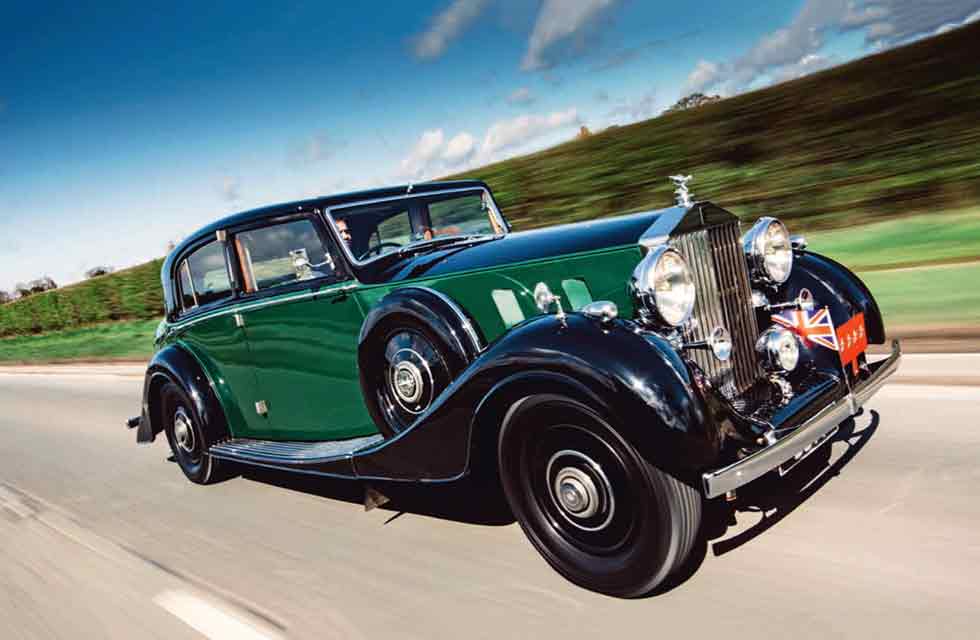
The manufacturing facilities and output of Great Britain’s motor industry had long since been requisitioned for purposes of rearmament. Marques such as Rover produced aero engines and airframes; MG made pots and pans, as well as refitting military trucks and aircraft. According to its own records, in addition to building hundreds of thousands of military vehicles – both light and heavy – the Austin Motor Company would supply some 1.3 million shells, 3.3 million ammunition boxes, 600,000 jerry-cans and 2.5 million steel helmets during the course of the Second World War.
‘The V12 overheated at over 65mph; the answer was to carry a bucket and top up the radiator from the Alpine streams’
Initially, most army vehicles were adaptations of pre-war designs, such as the numerous ‘Tillies’ – Car, Light Utility 4×2 – with canvas-covered rear load spaces replacing their original passenger compartments. In addition, huge numbers of Humber-, Daimler- and Austin-supplied vehicles, among others, were provided as Army staff and motor pool cars.
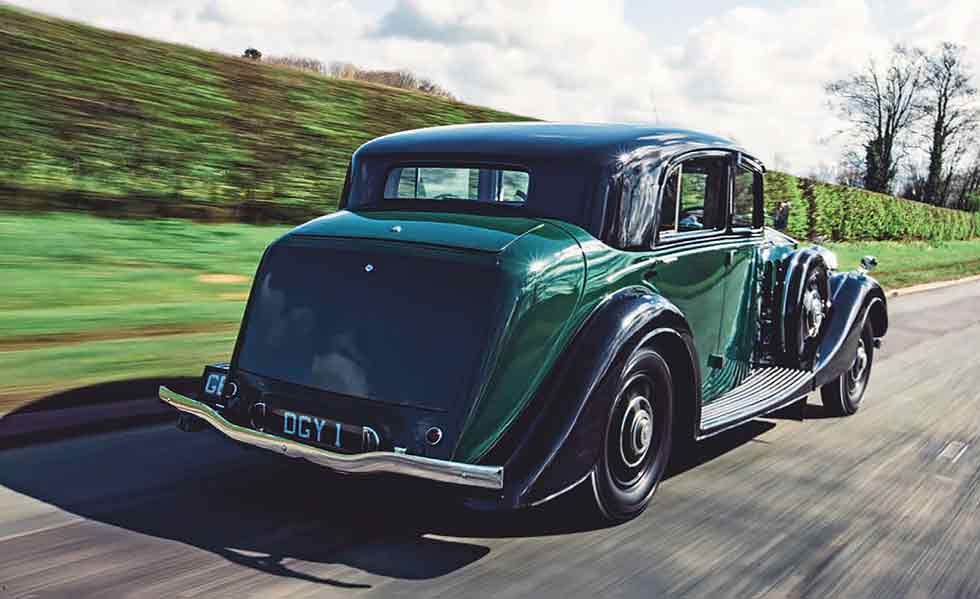
‘Even at speed the cabin is serene: nobody may have ever “won a war at 30mph”, but in a Phantom III you could certainly plan one’
The nous of industry giants including William Lyons of Jaguar and William Rootes at The Rootes Group had been used in the development of the huge Central Ordnance Depot, housed at Chilwell. At the outbreak of hostilities, this colossus employed 40 Royal Army Ordnance Corps officers and around 1000 of its soldiers, as well as 1300 civilians, to catalogue, stock and supply the millions of spare parts necessary – and carry out repairs – to support an exponentially growing array of British Army vehicles.
In government, too, the question of transport had raised its head. Prior to the war, only the Home Secretary was provided with an official car – in his case a police car. Two days after it began, at a meeting of the new War Cabinet, Prime Minister Neville Chamberlain agreed that there was a need for transportation to be made available to ministers.
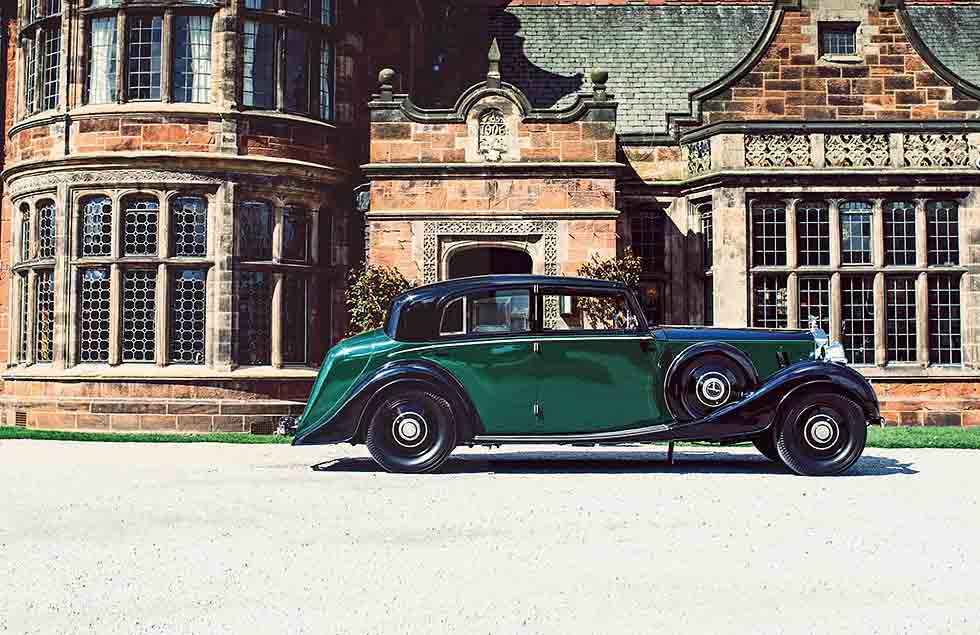
Despite multifarious grumblings regarding the possible use of faster – and, no doubt, more luxurious – cars, and with public opinion firmly in mind, motorcar hire company F Kidner & Son was instructed to provide six chauffeur-driven 20hp Austins. All good, except for the fact that Foreign Secretary Lord Halifax went rogue, taking up the offer of a Rolls-Royce from a Mr Lees – at no cost to the exchequer, but the precedent had been set.
It’s little wonder the Government urged prudence in the matters of official motoring. In his 1941 essay, The Lion and the Unicorn – Socialism and the English Genius, George Orwell would write: ‘At some point or another you have got to deal with the man who says, “I should be no worse off under Hitler.” But what answer can you give him – that is, what answer can you expect him to listen to – while common soldiers risk their lives for two-and-sixpence a day, and fat women ride about in Rolls-Royce cars, nursing pekineses?’
That said, to a certain extent the war placed growing social tumult on the backburner, and there were more than enough wealthy patriots willing to loan their distinctly high-end metal to the cause. Perhaps the most well-known of these is the 1937 Rolls-Royce Phantom III, chassis 3AX79. The body was built to the design specifications of the chairman of the De Havilland Aircraft Company, Alan Butler, with a distinctive reverse-rake windscreen.

Having been loaned to the War Office, it was allocated to the then-Chief of the Imperial General Staff (CIG) General Sir William Ironside.
Later in the war, when a policeman in London’s East End stopped chauffeur Percy Parker for suspected speeding, the reply of its rear passenger – Five-Star General, and Commander-in-Chief of the Allied Forces in Europe, Dwight D Eisenhower – would enter legend: “Nobody ever won a war at 30mph.” It’s also the Phantom III most associated with Field Marshal Montgomery, but wouldn’t be allocated for his use until he had himself assumed the position of CIG in 1946. By that time it had covered in the region of 300,000 miles, so Butler decided he no longer had use for the vehicle and it was sold to the War Office.
However it was the elegant Phantom III pictured here, chassis 3AZ186, that Montgomery used as his staff car when in Blighty towards the latter part of the conflict. It was ordered through Euston Road-based Rolls-Royce specialist Pass & Joyce Ltd, and buyer Frederick Wilcock had Touring Limousine coachwork completed by Freestone and Webb. A chartered accountant, he’d been a director of the English Talbot Motor Company since the 1920s and also enjoyed the ownership of an 8 Litre Bentley bodied by the same company.
After taking delivery on 30 November 1936, Wilcock principally used the Phantom III for travel between the family pile in Beckenham, Kent, and a holiday home in Angmering-on-Sea, Sussex. In July 1937 he embarked on his first Continental tour in his new car – a regular pastime of summers gone, in the Bentley. On the way to Paris, he found that the V12 overheated when exceeding 65mph, so dropped into the Talbot works in the city; its engineers deduced that the radiator was too small, and the only course of action was to carry a collapsible leather bucket, in order to top up the radiator from the Alpine streams of his destination countries. Climbing the majestic Grossglockner Pass, the Phantom III overtook an Austin Seven – only for the engine to once again go into meltdown at the top. When the Austin driver later enquired if he needed any help, Wilcock’s loss of face was brief because he turned out to be a Rolls-Royce employee on holiday, and his job was building Phantom IIIs. Back in England, its radiator was modified to cure the problem, and in September 1939 the car was laid up at Ham Manor.
As the war progressed, the Government’s earlier reticence over the use of ostentatious means of transport dissipated. A scheme to requisition large cars for the use of members of the War Cabinet was initiated and overseen by a body called ‘The Vehicle Acquisition Control Board’ at the Ministry of War Transport. One member who was a friend of Wilcock’s asked if he’d be willing to loan the Phantom III to Field Marshal Montgomery. He agreed – foregoing the need for a formal approach – but, just as Alan Butler had with 3AX79, gave the proviso that it couldn’t leave the country. With the car’s numerous personal design details, such as the separate golf-club housing at the top of the boot, he very much intended to use it again.
A quick turn behind the wheel is all that’s required to understand the complex Phantom III’s raison d’être. Progress is gloriously unhurried and refined, with the willing 7338cc V12 smoothly delivering its substantial torque. Despite this engine configuration being chosen mainly to save space compared to the long ‘six’ – and the car having an 8in shorter wheelbase than its predecessor – the Phantom IIIs are bigger and heavier overall thanks to their larger bodies and additional equipment. Yet the combination of a stronger chassis with independent front suspension – where the coil springs run in an oil-filled box – means that it has a softer ride than earlier products of Derby.
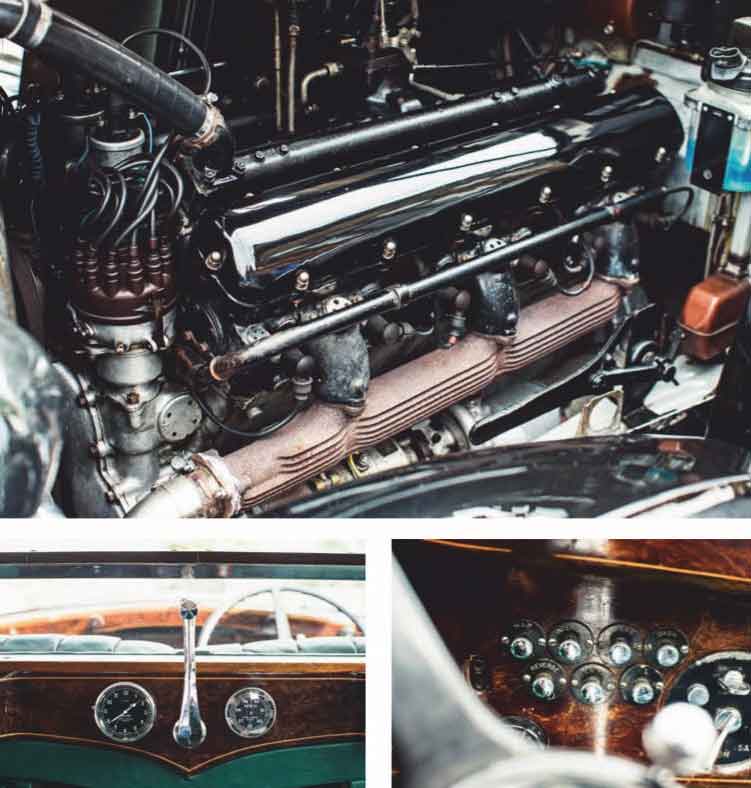
Nowhere is that more apparent than in the rear passenger compartment. Even at speeds well in excess of 50mph the cabin remains serene, with a barely perceptible murmur from the single tailpipe. You can imagine the creaking of leather being the loudest auditory intrusion as its occupant shuffled his papers, leant forward and continued writing his war correspondence on the well-located burr-walnut picnic table. Nobody may have ever “won a war at 30mph”, but in a Phantom you could certainly plan one.
Wilcock’s insistence that the Phantom III remain in Great Britain put the kibosh on War Office plans, because it had already earmarked the car for overseas duties. Instead, it would purchase not one but two Wraiths for this purpose. Montgomery continued to use 3AZ186 throughout 1944, before it was transferred to the American Air Force and used by General Carl Spaatz. At some point during this time, a tanker reversed into it at the Air Force’s north London base and it was poorly repaired.
In mainland Europe, both Wraiths landed shortly after D-Day, 6 June 1944. The question remains as to why there were two. Rolls-Royce historian Tom Clarke hypothesised: ‘It must be highly likely that WMB40 was brought to Europe for significant occasions, such as carrying high-ranking visitors alongside WHC43.’
This makes sense because both Prime Minister Winston Churchill and His Majesty King George VI would require suitable transport on their troop visits. WHC43 was the only car purchased in Monty’s name by the War Office, and would remain his Rolls-Royce on the Continent. With the enemy on the retreat, the use of these cars would have conveyed the image of prestige Montgomery felt necessary – especially in contrast to the caravan of Ford, Mercury and Cadillac cars of Eisenhower. ‘When the Rhine was crossed by the 21st Army Group,’ wrote Clarke, ‘leading to the crossing of the Siegfried Line, Churchill drove with Monty in WHC43 to see the devastated city of Wesel.’
With Germany’s final surrender on 8 May 1945, WHC43 became the lone official car. 3AX79 is known to have carried a number of luminaries – including Winston Churchill, King George VI and Eisenhower – during the planning and build-up to D-Day, and it’s highly likely that Wilcock’s Phantom III did the same. Having done its duty, it was returned to its owner in the autumn of 1944, but sadly the following year Wilcock died at the age of just 47.
The Second World War changed Britain for good, heralding the introduction of a fully mechanised and ‘modern’ army, and accelerating societal changes that were already in the offing before the conflict. The staff cars used by the British Army and Government, both requisitioned and donated, reflected the identity crisis in British culture at the time – Austins et al at the start projecting a hierarchy perceptive of class injustices, with later Rolls-Royces exuding prestige and allowing for one last flourish of Empire. Part-strategist, part-warrior, but always the showman, Monty knew exactly how to motivate his troops and convey an expectation of victory.
Whether it was rousing them in north Africa, standing on the bonnet of his Humber ‘Old Faithful’, or foregoing warnings of snipers to thrust deep into France in his Rolls-Royce, flanked by eight motorcycle outriders and with a Union Jack on the bonnet, there’s no doubt he used his staff cars with purpose.
Thanks to Iain Tyrrell (www.iaintyrrell.co.uk)
TECHNICAL DATA FILE SPECIFICATIONS ROLLS-ROYCE PHANTOM III
Sold/number built 1936-1939/710
Construction steel box-section chassis, custom bodywork
Engine all-alloy, ohv 7338cc V12, single twin-choke Stromberg carburettor
Max power 170bhp @ 3500rpm
Max torque 325lb ft @ 1500rpm
Transmission four-speed manual, RWD
Suspension: front independent by wishbones, coil springs rear live axle, semi-elliptic leaf springs, anti-roll bar; hydraulic dampers f/r
Steering worm and sector
Brakes drums, with servo
Length 17ft 7in (5359mm)
Width 6ft 5in (1958mm)
Height 5ft 1in (1650mm)
Wheelbase 11ft 10in (3607mm)
Weight 6100lb (2770kg)
0-60mph 16.8 secs
Top speed 92mph
Mpg 8
Price new £2600
Price now from £120,000
Top: the V12-powered Phantom III offers regal progress. Above: letter from the Ministry of War Transport requesting the Phantom’s presence. Clockwise from main: chauffeur’s area is workmanlike; imposing grille; commemorative plaque; cutouts for gearlever and handbrake. Clockwise from main: discreetly elegant F&W body; whispering V12; sophisticated switchgear for 1936; barometer and clock for rear passengers. Rear picnic table doubles as a sturdy writing desk – its easy to imagine the illustrious head of the British Army dashing out instructions for the Front.
MONTGOMERY’S BATTLE STEEDS
HUMBER SUPER SNIPE – M239459
Known affectionately as ‘Old Faithful’, this 1941 tourer (above) was attached to Montgomery’s Tac HQ, and used as his personal chauffeur-driven transport during his campaigns with the Eighth Army in north Africa, Sicily and Italy.
ROLLS-ROYCE WRAITH – FLD 99
The Park Ward-bodied chassis WMB40 was damaged in a 1940 air raid, then repaired and donated to the War Office in 1944 by Donald FS Henderson of Bowater Group. Given to Monty’s Tac HQ, it landed in Normandy on 6 June 1944.
HUMBER SUPER SNIPE – M239485
This 1943 Thrupp & Maberly-bodied tourer (above) was known as the ‘Victory Car’ and used by Monty between the D-Day landings and the end of the war in Europe. It famously fell into the sea off a Mulberry harbour, but was salvaged and running again within 24 hours.
ROLLS-ROYCE WRAITH – 16 YF 67
The second of Monty’s Wraiths, chassis WHC43 was built in 1939 and endowed with a limousine body by Windovers. Originally destined for the Maharajah of Gwalior, it went into storage after the order was cancelled until being acquired by the Ministry of War Transport in 1944.
ROLLS-ROYCE PHANTOM III – 16 YF 66
Chassis 3AX79 (above) was built in 1937 and clothed with unique HJ Mulliner coachwork. It was provided by Alan Butler, the chairman of De Havilland, and used by numerous CIGs before Montgomery bought it upon his retirement.


